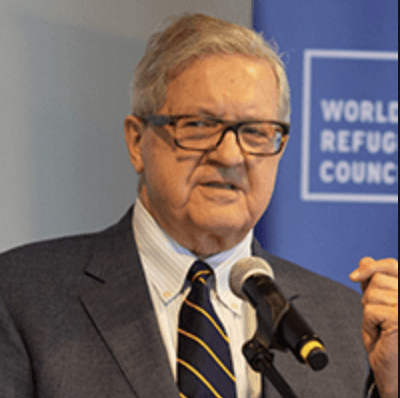Lloyd Axworthy and Fen Osler Hampson are the chair and the president, respectively, of the World Refugee & Migration Council. This article was first published in the The Globe and Mail.
Next month, on the second anniversary of Russia’s invasion of Ukraine, G7 leaders will meet to discuss the potential confiscation of approximately US$300-billion in Russian central-bank assets that are sitting frozen in G7 countries, as well as in non-members Switzerland and Belgium.
Ukraine’s urgent need for those assets is blatantly obvious. Russian missiles and drones continue to rain down on Ukrainian cities, and Moscow has launched a major new military offensive. In a speech this week at the World Economic Forum, Ukrainian President Volodomyr Zelensky said that redirecting seized Russian assets to Ukraine is “not only effective as a punishment for the aggressor, but also quite fair.” Three high-level working groups in the G7 are now studying the legality of confiscating these assets, how countries would implement such a policy around the Russian assets, and the best ways those funds could be used to support Ukraine.
But the deal is not done, because pettifogging, foot-dragging and intra-group divisions stand in the way. Canada and Britain support confiscation on the grounds that it is legally and morally the right thing to do. The U.S. and Japan are still undecided, but are warming to the idea. But Germany, France and Italy are worried that Russian President Vladimir Putin will retaliate against European companies that still do business in Russia. Belgium, a major holder of Russian assets and the current chair of the European Union’s rotating presidency, opposes confiscation altogether. The group might well settle by implementing a windfall tax on the frozen funds, but that would result in small change compared to what’s needed to save Ukraine.
Canada needs to challenge these self-interested obstructions. To its credit, Canada has already taken the lead on asset forfeiture, announcing changes to its sanctions legislation in 2022 as well as the forfeiture of some $26-million in a Canadian company owned by sanctioned Russian oligarch Roman Abramovich; last year, the federal government seized a Russian-owned heavy-lift cargo jet with plans to transfer it to Ukraine. It must now be the voice of reason and conviction at the G7.
If the central-bank assets are confiscated, how should the money be used? There is of course evident pressure to use it to support Ukraine’s military effort. But Western leaders should not lose sight of the vital need to direct some of those funds to support Ukraine’s struggling economy and the basic needs of the Ukrainian people — particularly the families of the many soldiers and civilians who have died fighting valiantly for their freedom and democracy, and the millions of Ukrainian refugees living abroad.
Kyiv is now staring at a US$43-billion deficit in 2024, which will not be easily plugged by the European Union’s package of financial aid, which Hungarian Prime Minister Viktor Orban opposes, nor by the Joe Biden administration’s billion-dollar aid package, which Republicans are still blocking in Congress. U.S. financial support already accounts for roughly a third of Ukraine’s total budgetary expenditures.
A major funding shortfall, which could run into the tens of billions of dollars, would take a significant bite out of Ukraine’s already cash-strapped social, educational and health systems, and the government’s efforts to support low-income citizens. The figures are staggering: Estimates suggest that 50 per cent of Ukrainian households are barely eking out a subsistence living, and roughly a quarter of the population can barely put food on the table. Those numbers will keep rising the longer the war drags on.
Those funds also don’t cover much-needed repairs to Ukraine’s energy grid and its transportation infrastructure, its homes, its schools, and its hospitals, much of which has been damaged or destroyed by Russia’s relentless attacks and are intensifying with the onset of another winter. Estimates put the costs of Ukraine’s reconstruction and recovery in the next decade to be anywhere from US$400-billion to US$750-billion — and rising.
Polls also show that Ukrainians are growing weary of the toll that the war is taking on lives and livelihoods — sentiments that Mr. Putin clearly wants to exploit, so that Mr. Zelensky’s government collapses from within. However, while support is softening, polls still show that Mr. Zelensky is popular and trusted. There is also a heated debate in the country about whether the presidential election scheduled for March should take place because the country is in the middle of an existential war. That debate that has spilled over into Washington, with some Republicans arguing that more money should not be given to Ukraine unless it holds elections.
The way to leapfrog these political barriers is for G7 leaders to take Russia’s money now and redirect it to Ukraine. Canada would do well to remind nervous Europeans that this is no time to go wobbly and appease Mr. Putin, because the future of Ukraine — and Europe — now hang in the balance.


